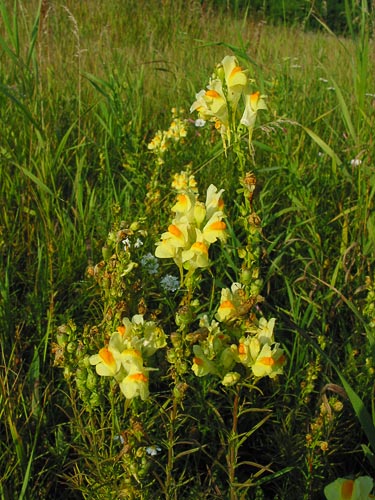Weeds
Linaria vulgaris (L.) Mill. - Yellow Toadflax
Systematic position.
Family Scrophulariaceae, genus Linaria Mill.Synonyms.
Antirrhinum repens L.Biological group.
Creeping-rooted perennial plant.Morphology and biology.
Root stalky or having long creeping shoots. Stems 30-60 (90) cm in length, erect, single or branchy, thickly covered with leaves. Leaves lanceolate-linear or linear, pointed, with 1 or rarely 3 nerves, bent along margins, glabrous, 2-5 (7) cm in length, 2-4 (5) mm in width; upper leaves linear. Flowers aggregated in thick bunches, 5-15 cm in length; rachides, peduncles, and rarely calyx covered with glandular hairs, or very rarely almost glabrous. Corolla yellow, with bright orange protuberance on lower lip, 15-18 mm in length (without spur); upper lip considerably exceeding lower one. Spur wide-conical, curved, 12-15 mm in length, 2.5-3 mm in width, bright yellow at base. Pod oblong-elliptical, 9-11 mm in length, 6-7 mm in width; seeds 1.7-2.3 mm in diameter, 0.2-0.3 mm in thickness, disk-shaped, dark-brown, with wide membranous edge, tuberous in center; weight of 1000 seeds about 0.2 g. Main root penetrates in soil to 80-100 cm. Sprouting seeds meet rarely in fields. The seeds germinate from depth of no more than 4 cm at temperature 6°C and more (optimal temperature is +22-26°C). Fertility to 30 000 seeds. Vegetative reproduction is the main manner of reproduction (numerous adventitious buds giving rise to new shoots develop on the main and lateral roots). VI-VIII.Distribution.
European part, Western Siberia (rare), the Far East (alien). Outside the former USSR: Scandinavia, Atlantic and Middle Europe.Ecology.
Common plant in ditches, on waste lands, along road sides, in coniferous forests, and on sand soils in forest and seldom in forest-steppe zones.Economic significance.
Very rare weed in crops of grain cultures at borders of fields, near boundary-strips, on badly treated plots. It grows more often in perennial grasses, penetrating deep into fields, but being here not abundant, meeting only in fields, where recommended agronomic measures are not observed. Overall, it is a plant of ruderal habitation. Control measures: grain-grass, vegetable-grass, and grain-grass-rootplant rotations; plowing and deep cultivation by combined aggregates in spring; interrow treatments in tilled cultures; stubbling with succeeding plowing (in 2-3 weeks) by ploughs with coulters.Related references:
Agaev, M.G., ed. 1988. Main agricultural weeds in crops of the Leningrad Region. In: Catalogue of VIR world collection. Issue 468. Leningrad: VIR. 112 p. (in Russian).Artokhin, K.S. 2004. Atlas of Weed plants. Rostov-na-Donu. 144 p. (in Russian).
Nikitin, V.V. 1983. Weed plants of the USSR flora. Leningrad: Nauka. 454 p. (in Russian).
Shishkin, B.K. & Bobrov, E.G., eds. 1955. Flora of the USSR. V. 22. Moscow; Leningrad: AN SSSR. 861 p. (in Russian).
Ul.yanova, T.N. 1998. Weed plants in flora of Russia and other FSU countries. Saint-Petersburg: VIR. 233 p. (in Russian).


